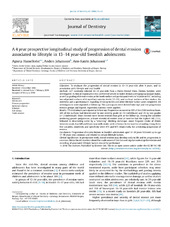| dc.contributor.author | Hasselkvist, Agneta | en_US |
| dc.contributor.author | Johansson, Anders | en_US |
| dc.contributor.author | Johansson, Ann-Katrin Gerd | en_US |
| dc.date.accessioned | 2017-03-30T13:34:22Z | |
| dc.date.available | 2017-03-30T13:34:22Z | |
| dc.date.issued | 2016-04 | |
| dc.Published | Journal of Dentistry 2016, 47:55-62 | eng |
| dc.identifier.issn | 1879-176X | |
| dc.identifier.uri | https://hdl.handle.net/1956/15621 | |
| dc.description.abstract | Objectives To evaluate the progression of dental erosion in 13–14 year-olds after 4 years, and its association with lifestyle and oral health. Methods 227 randomly selected 13–14 year-olds from a Public Dental Clinic, Örebro, Sweden, were investigated. A clinical examination was performed which included dental caries/gingival/plaque status, as well as grading of dental erosion at the tooth surface and participant levels in “marker teeth”, including buccal/palatal surfaces of 6 maxillary anterior teeth (13–23), and occlusal surfaces of first molars. An interview and a questionnaire regarding drinking habits and other lifestyle factors were completed. All investigations were repeated at follow-up. The participants were divided into high and low progression erosion groups and logistic regression statistics were applied. Results 175 individuals participated at follow-up. Progression occurred in 35% of the 2566 tooth surfaces. 32% of the surfaces had deteriorated by one severity grade (n = 51 individuals) and 3% by two grades (n = 2 individuals). Boys showed more severe erosion than girls at the follow-up. Among the variables predicting greater progression, a lower severity of erosive wear at baseline had the highest OR (13.3), followed in descending order by a “retaining” drinking technique, more frequent intake of drinks between meals, low GBI and lesser sour milk intake, with reference to the baseline recording. Using these five variables, sensitivity and specificity were 87% and 67% respectively, for predicting progression of erosion. Conclusions Progression of erosive lesions in Swedish adolescents aged 13–14 years followed up to age 17–18 years was common and related to certain lifestyle factors. Clinical Significance In permanent teeth, dental erosion may develop early in life and its progression is common. Dental health workers should be made aware of this fact and regular screenings for erosion and recording of associated lifestyle factors should be performed. | en_US |
| dc.language.iso | eng | eng |
| dc.publisher | Elsevier | eng |
| dc.relation.ispartof | <a href="http://hdl.handle.net/1956/17405" target="blank">A longitudinal study of dental erosion and associated lifestyle factors in a group of Swedish</a> | |
| dc.rights | Attribution CC BY NC ND | eng |
| dc.rights.uri | https://creativecommons.org/licenses/by-nc-nd/4.0/ | eng |
| dc.subject | Adolescent | eng |
| dc.subject | Disease progression | eng |
| dc.subject | Incidence studies | eng |
| dc.subject | Lifestyle | eng |
| dc.subject | Soft drinks | eng |
| dc.subject | Tooth erosion | eng |
| dc.title | A 4 year prospective longitudinal study of progression of dental erosion associated to lifestyle in 13-14 year-old Swedish adolescents | en_US |
| dc.type | Peer reviewed | |
| dc.type | Journal article | |
| dc.date.updated | 2016-12-13T14:45:08Z | |
| dc.description.version | publishedVersion | en_US |
| dc.rights.holder | Copyright 2016 the authors | |
| dc.identifier.doi | https://doi.org/10.1016/j.jdent.2016.02.002 | |

